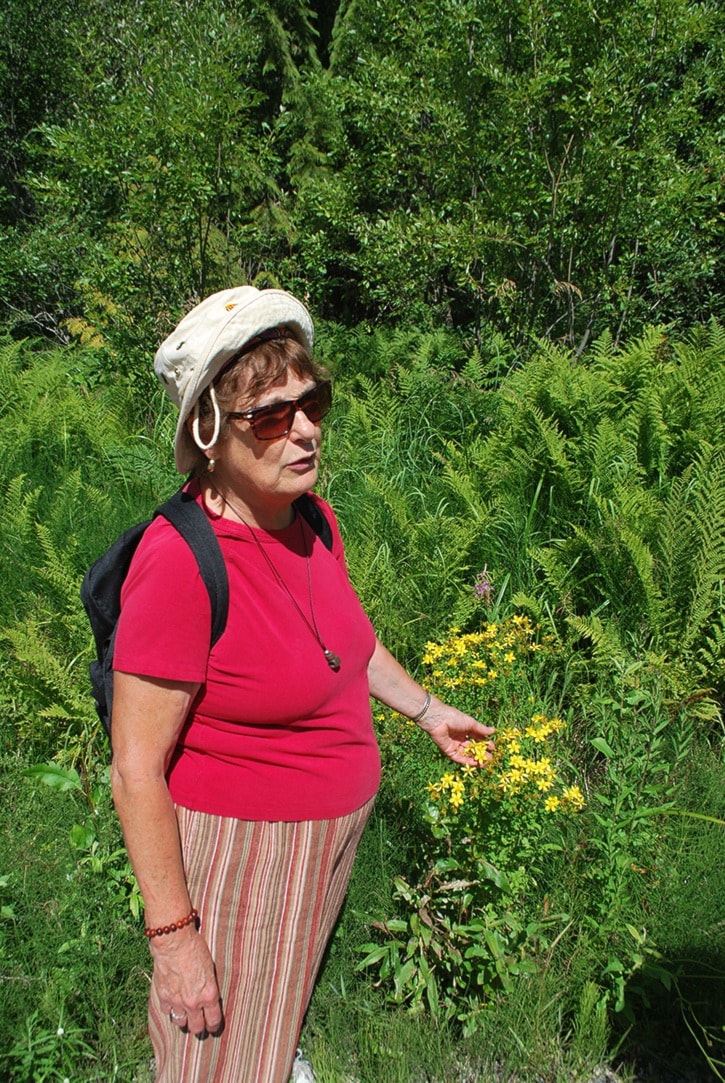Our small party clambered out of Barb MacPherson’s vehicle near the mouth of the Trailway leading to Summit Lake from the New Denver side. After the herbal plant walk was done, I was hoping to be able to forage and find a plant that would be good for all ailments, on the same scale as, say, chocolate.
Bev Detta, Gale Detta and I followed Barb MacPherson toward the trail, but even before we had reached the path, MacPherson was pointing at a spindly powder-blue flower and asking if we knew what it was. I knew it by the name chicory, but our guide also called it Blue Sailor, and said it could be roasted, ground and prepared like coffee. MacPherson had tried it herself, with mixed results: the taste hadn’t converted her to taking a cup every morning.
MacPherson’s own faith in natural remedies was cemented with her experience taking Feverfew. Having suffered migraines for years, she turned to the herb to alleviate the pain she would often have to suffer through. The small, bright green, flowery brought her a relief she has come to rely on. Now, everyday, she takes a dropperful of tincture and hasn’t suffered a blinding migraine since. Although the cure has worked for her, she realizes that it might not work for all migraine sufferers, but it could help some.
Not long after, she had a tall yellow-flowered plant in hand and was showing us how the yellow flowers yielded a reddish liquid when rolled between fingers. This was St. John’s Wort, which could be taken for nerve pain or depression, or soaked in oil and used on sunburns.
“You can find good plants everywhere,” she told us, pointing to Pearly Everlasting, which was growing by the side of the road and was good for colds and flus, she said. Horsetail contains silica and is good to gather in spring when the crystals or small. Eyebright, Shasta Daisies, White Clover, Betony, Angelica: all have healing powers MacPherson explained, pointing each out as we walked along the path. Heal-all, aka Prunella vulgaris, is high in anti-oxidants, Small-flower Willow Herb is good for prostate problems, and Pyrola can be taken for kidney issues.
Gathering plants for their medicinal or nutritional benefits is an ages-old past time that predates pharmacology, but you have to be cautious, MacPherson told us. Always carefully identify the plants you gather with a field guide, and an experienced herbalist if possible. She herself had learned from a very memorable personal experience that elderberries need to be cooked before they’re consumed. Some plants should be avoided, like the buttercup family, as should most lilies.
“They’re very inviting, especially when they’re young,” MacPherson said, referring to a tall False Hellebore, aka Veratrum viride, growing along the side of the path. There are several members in the skull-and-crossbones club of the plant world, so be cautious, she warned.
Aside from being wary of the poisonous, there are other good rules of thumb for collecting plants, such as not taking too much from one area (one guide recommends taking only five per cent of one crop of common plants). Don’t take plants that are rare or protected or in nature preserves, and take only what you need. This means you should know what part of the plant you’re collecting, and gather it at the time when that part is most full of life.
“Chemical constituents vary over a season,” said MacPherson, who gave the example of plants sending out pheromones to attract or repel insects and pollinators. One extreme example of plant persuasion that she had heard about was an acacia that had sent out chemicals in response to over browsing which had killed feeding antelopes. A study was also done into the effects of over-browsed Artemisia inhibiting the reproduction of partridges.
The signals sent out by plants aren’t all bad, of course. There is a practise in Japan called Shinrin-yoku, or forest bathing, said our guide, where visitors to the treed areas reap the benefit of breathing in volatile essential oils called phytoncides. The practise is seen as good for defusing stress and relaxing.
As we walked through the forest, MacPherson pointed out Oregon Grape – the root is good for the liver, but it is rare in some areas – and Devil’s Club, which can be taken to regulate blood sugars. Reaching the end of the trail, the herbalist pointed out Wild Strawberry, well known for its delicious fruit but less known for its astringent and anti-oxidant properties. As we walked back to the truck, we sighted a folded-up blue heron flying lazily by, flapping its enormous wings, another side effect of taking a walk in wild places.
“Some people were taught the uses of plants by their family. That’s so uncommon now,” she said. MacPherson would love to pass on her knowledge, and it all starts with learning the plants, getting out to see what grows where, then learning how it’s used. Not many people seem to have time, but considering the benefits of just walking in nature, who can really afford not to?
